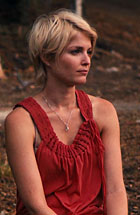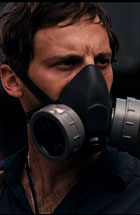Scoot McNairy and Whitney Able have to cross an infected zone peopled by aliens in Gareth Edwards's Monsters.
This time last year, the film world was raving about how Avatar was going to "change the game" (even that expression feels so 2009), but it could turn out we were looking in the wrong direction. For sure, Avatar has changed the movie landscape: without it, we'd never have had such 3D delights as The Last Airbender, Resident Evil: Afterlife and Garfield's Pet Force. But perhaps the industry should have been looking harder – and worrying more – about Monsters.
- Monsters
- Production year: 2010
- Country: UK
- Cert (UK): 12A
- Runtime: 94 mins
- Directors: Gareth Edwards
- Cast: Scoot McNairy, Whitney Able
Directed by 35-year-old Brit Gareth Edwards, this is another credible alien sci-fi movie. But instead of Avatar's blue cheese, it servers up hipster indie vibes and, despite the title, offers a genuine alternative to your standard monster-movie fare. What's really striking about Monsters, though, is that the entire film was put together using standard equipment and off-the-shelf computer software, for around half-a-million dollars – which is probably less than James Cameron's on-set beard technologist gets.
"The history of cinema has always been an industrial process where you needed hundreds of people to make a movie, and that's just not true any more," says Edwards. "Now you can just do it with a handful." At least, you can if you're a multi-tasking maverick like Edwards, who's officially Monsters' director, writer, cinematographer, production designer and visual effects supervisor. The latter is the key: he wasn't actually supervising anyone; he did all the effects himself in his bedroom.
But without 10 years' experience doing effects for TV, Edwards would never have been able to envisage doing a movie like Monsters. It was also seeing the inefficiency of the studio process that inspired him. "Sometimes you'd have 100 people on the set and you'd ask, 'Can we do this? Can we do that?' And they'd say, 'No, we can't, because we'd have to move all these people. It's too expensive and it would take too long.' That felt very back to front: to be told you can't do something because you're spending too much money. Shouldn't it be the other way round?"
But the story of how Edwards made Monsters is destined to be retold more than the story of the movie itself. It's set in the near future, six years after a crashed space probe resulted in an "infected zone" between Mexico and the US. Our heroes, a world-weary freelance photographer (Scoot McNairy) and his boss's daughter (Whitney Able), must cross this aggressively quarantined zone to get back to the US. The aliens that lurk there – sort of giant walking octopuses – are rarely shown, but their presence is continually implied by ruined ships and aircraft (strewn like toys across derelict landscapes), giant border walls, patrolled fences, and huge warning signs everywhere telling people to stay the hell away.
"I was about to try and do a 'Blair Witch meets War Of The Worlds', shooting it all on a video camera," Edwards explains, "and then the Cloverfield trailer came out, and I thought, 'Oh. Damn. Right, can't do that, then ..."
'We grabbed people in the street and asked if they wanted to be in the film. It was very guerrilla, really'

If Cloverfield is like 9/11, then Monsters is more present-day Afghanistan, he says. "It's years later, no one cares, it's the other side of the world and it's somebody else's problem." And instead of Cloverfield's disaster-movie dynamics, Monsters gives you more of a low-key indie road romance. Something like Before Sunrise meets District 9, or maybe Predators meets In Search Of A Midnight Kiss (which, coincidentally, also starred McNairy).
Most of the film was shot with a crew of just four: Edwards behind the camera, a sound man, a line producer and his Spanish-speaking equivalent. And they basically made it up as they went along, driving through Central America in a van with the actors. They'd ask around for any out-of-the-ordinary, post-apocalyptic-looking stuff nearby, then jump out, shoot a scene (improvised, of course) and move on, editing on a laptop in hotels at night. "We had a rough plan but most of the time when we turned up, it was the first time we'd ever been there. We grabbed people in the street and asked if they wanted to be in the film. It was very guerrilla, really." When they got back home, Edwards added in the monsters, the signs, the barricades, the crashed planes, the ruined buildings … In fact, the whole sci-fi element was added retrospectively in his bedroom.
It sounds like every aspiring film-maker's dream, a sort of gap-year backpacking holiday with a movie shoot thrown in. Edwards doesn't remember it like that, though. On top of hazardous local conditions, illnesses, back pains and other hardships, it was endless stress and pressure and exhaustion. "I sit and watch the film now," he says, "and I think, 'That looks like an adventure. I wish I'd gone on that trip. And then I realise, 'Oh yeah. I did. It was horrible.'"
That probably won't put people off following Edwards's example; after all, there's more processing power in a decent PC now than it took to make, say, Jurassic Park. Indeed, Edwards made Monsters using Adobe's After Effects software, a widely available cousin of Photoshop. Finding no plug-in for alien tentacles, he adapted a program that models rope. The CGI planes and cars you see were all bought off the internet, like real props.
To misquote Jean-Luc Godard, all you need to make a movie is a girl and laptop, right? Perhaps. But it might take more than a splurge in Dixons, warns Edwards. "When I first bought a computer in 1997, I thought, 'I'll learn this software and a few months later I'll make a movie.' It took me nearly a decade to get good enough at it," he says modestly.
'Anyone who says they know what's going to happen in film-making is lying, but it's definitely changing'

And he's right to be cautious. He's not the only one doing this: visual effects expertise is now a regular route to the director's chair. There's the Brothers Strause, owners of California effects house Hydraulx, who directed Alien Vs Predator: Requiem and current alien-invasion flick Skyline. There's Scott Charles Stewart, who contributed effects to the Harry Potter and Pirates Of The Caribbean franchises and also directed this year's Legion (the one with Paul Bettany as an angel) and the forthcoming Priest (the one with Paul Bettany as, er, a priest). And, most notably, there's South Africa's Neill Blomkamp, who also spent 10 years doing CGI before striking gold with District 9 (like Monsters, District 9 put special effects where we weren't used to seeing them).
Now, the danger is, with effects people wagging the dog, you'll tend to get a certain type of movie out of it. Effects-centric directors don't make costume dramas or romcoms. For every District 9, there are a dozen examples of the type of mindless, bludgeoning sci-fi epic we've all grown heartily sick of, like Skyline, which boasts A-grade special effects but a depressingly mindless script. Monsters, too, has its weaknesses – its "aliens and indigenous folks = good; US military = bad" motif is really not so far removed from Avatar's – but it at least does something fresh, story-wise as well as budget-wise.
For his next mission, Edwards has teamed up with Russian effects ace Timur Bekmambetov, of Night Watch and Wanted fame, to make something more ambitious and bigger budget, but incorporating his guerrilla approach. In the meantime, if Monsters does well, the cash-strapped studios will doubtless wonder if they're not better off getting 500 films like it for the same price as one Avatar.
"Anyone who says they know what's going to happen in film-making is lying, but it's definitely changing," says Edwards. "It reminds me of that era when people like Spielberg and Scorsese turned up, when the studios didn't understand this new young audience and all those people got a chance to play and make artistic films.
"No one's too sure what the future's going to be," he continues. "So if you can grab a camera and tell a story, there's a good chance you can do something. In the chaos, there's always opportunity."
Sunday, November 28, 2010
Great production story - read!: Monsters: the bedroom blockbuster that's the anti-Avatar
via guardian.co.uk
Subscribe to:
Post Comments (Atom)




No comments:
Post a Comment